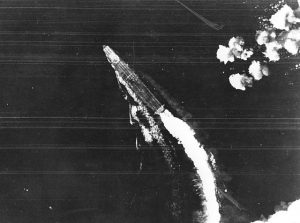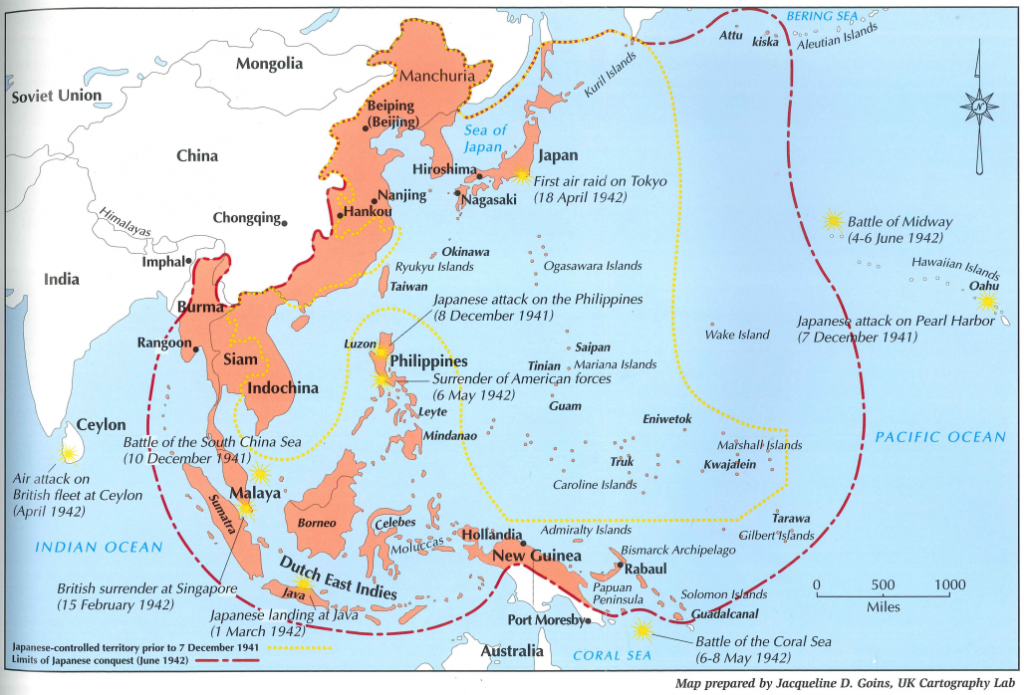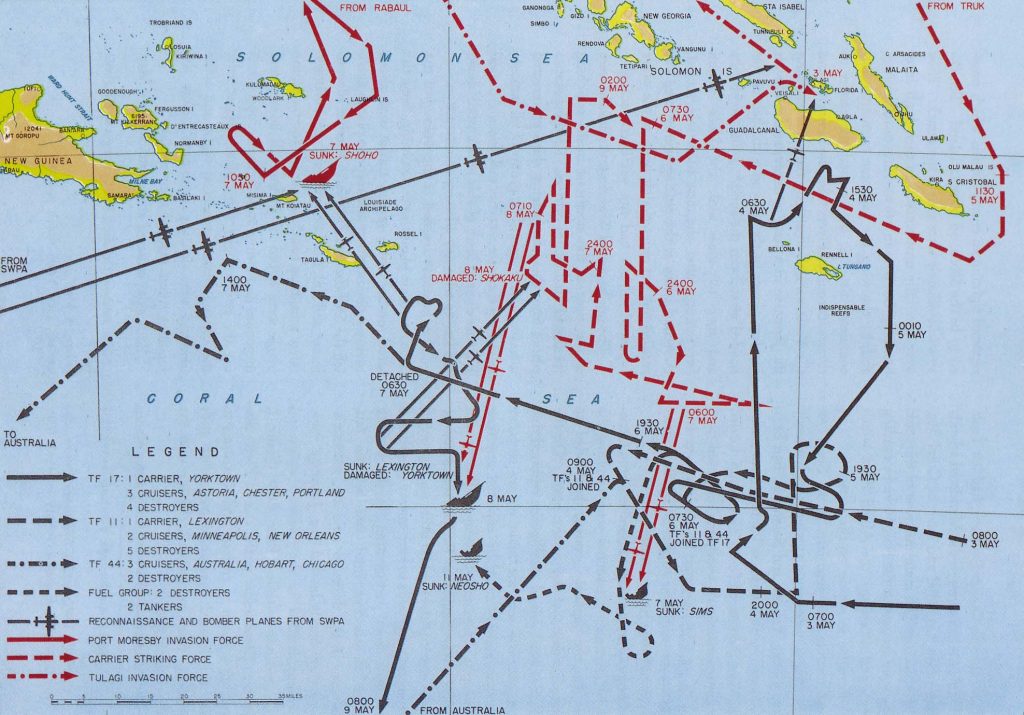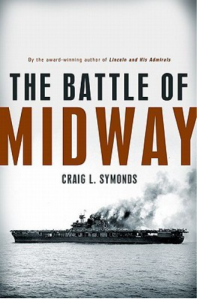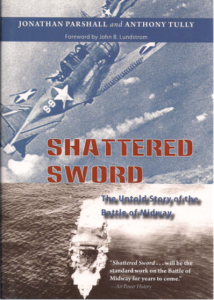Battle of Coral Sea
Battle of Coral Sea
Overview
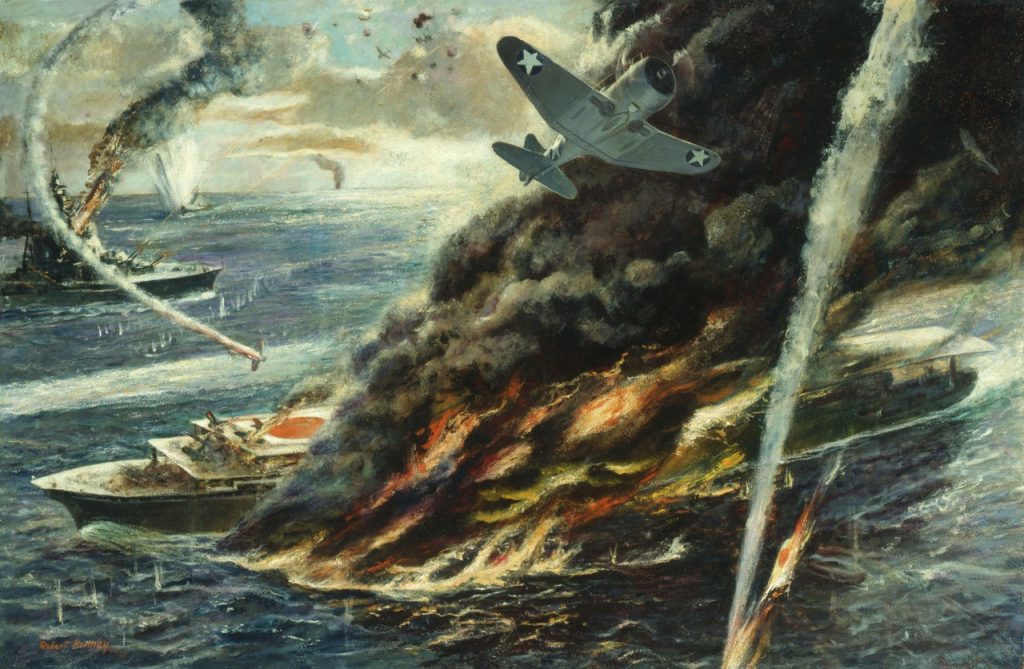
The Battle of the Coral Sea was the first time since the Japanese attack on Pearl Harbor that the enemy’s seemingly relentless advance into the Pacific was checked. It was also the first major U.S. Navy fleet action against Japan and the first naval engagement in history in which the participating ships never sighted or fired directly at each other.(5)
The Coral Sea action resulted from a Japanese amphibious operation intended to capture Port Moresby, located on New Guinea’s southeastern coast. A Japanese air base there would threaten northeastern Australia and support plans for further expansion into the South Pacific, possibly helping to drive Australia out of the war and certainly enhancing the strategic defenses of Japan’s newly-enlarged oceanic empire.
The Japanese operation included two seaborne invasion forces, a minor one targeting Tulagi, in the Southern Solomons, and the main one aimed at Port Moresby. These would be supported by land-based airpower from bases to the north and by two naval forces containing a small aircraft carrier, several cruisers, seaplane tenders and gunboats. More distant cover would be provided by the big aircraft carriers Shokaku and Zuikaku with their escorting cruisers and destroyers. The U.S. Navy, tipped off to the enemy plans by superior communications intelligence, countered with two of its own carriers, plus cruisers (including two from the Australian Navy), destroyers, submarines, land-based bombers and patrol seaplanes.
Preliminary operations on 3-6 May and two days of active carrier combat on 7-8 May cost the United States one aircraft carrier, a destroyer and one of its very valuable fleet oilers, plus damage to the second carrier. However, the Japanese were forced to cancel their Port Moresby seaborne invasion. In the fighting, they lost a light carrier, a destroyer and some smaller ships. Shokaku received serious bomb damage and Zuikaku’s air group was badly depleted. Most importantly, those two carriers were eliminated from the upcoming Midway operation, contributing by their absence to that terrible Japanese defeat.(9)
Where is the Coral Sea? (on the very bottom right on the map below)
Map of the Pacific Theatre in 1941 - 1942
Map Source:
Goins, Jacqueline D. (2002) “WWII Pacific Theatre Maps,” Kaleidoscope: Vol. 1, Article 15.
Available at: https://uknowledge.uky.edu/kaleidoscope/vol1/iss1/15
Map showing the Battle of Coral Sea
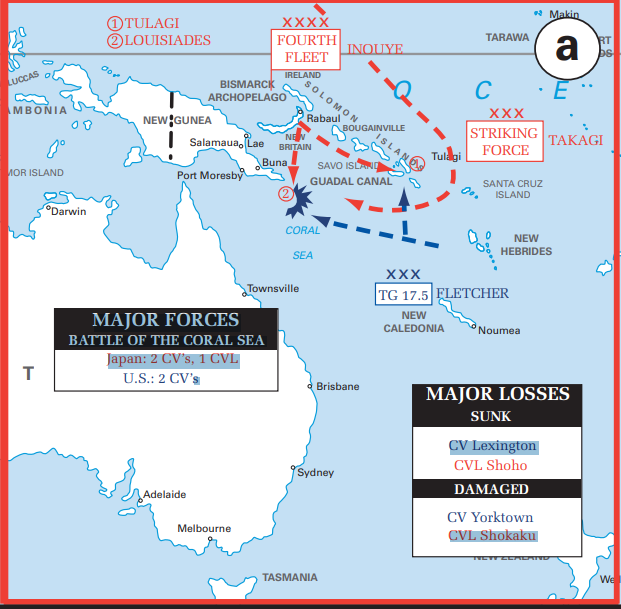
Map showing the Force Movements at the Battle of the Coral Sea
Map Source: Wikipedia.com
The Forces

U.S. Forces
Admiral Chester W. Nimitz, Command in Chief, Pacific Ocean Areas
Vice Admiral Frank Fletcher (overall tactical commander)
Task Force 17 (Carrier Group)
Commanded by Rear Admiral Frank Fletcher
Heavy Aircraft Carriers
Task Force 17 (Carrier Group)
Commanded by Rear Admiral Frank Fletcher in Yorktown
Heavy Aircraft Carriers
The task organization of combatant unit was as follows:
Task Force (17) –
Rear Admiral Aubrey W. Fitch (overall command)
Carrier (air) group (17.5) –
Rear Admiral Aubrey W. Fitch (Officer in Tactical Command (OTC):
- USS Yorktown (CV-5) – Capt. Elliott Buckmaster
- Air Group (Lt. Cmdr. Oscar Pederson)
- Fighting 42 (VF-42): 17 F4F Wildcat fighters (Lt. Cmdr. Charles R. Fenton)
- Bombing 5 (VB-5): 18 SBD Dauntless dive bombers (Lt. Wallace C. Short)
- Scouting 5 (VS-5): 17 SBD Dauntless scout bombers (Lt. Cmdr. William O. Burch, Jr.)
- Torpedo 5 (VT-5): 13 TBD Devastator torpedo bombers (Lt. Cmdr. Joe Taylor
- Air Group (Lt. Cmdr. Oscar Pederson)
- USS Lexington (CV-2) – Capt. Frederick C. Sherman.
- Air Group (Cmdr. William B. Ault)
- Fighting 2 (VF-2): xx F4F Wildcat fighters (Lt. Cmdr. Paul H. Ramsey)
- Bombing 2 (VB-2): 18 SBD Dauntless dive bombers (Lt. Cmdr. Weldon L. Hamilton)
- Scouting 2 (VS-2): 17 SBD Dauntless scout bombers (Lt. Cmdr. Robert E. Dixon)
- Torpedo 2 (VT-2): 12 TBD Devastator torpedo bombers (Lt. Cmdr. James H. Brett, Jr.)
- Air Group (Cmdr. William B. Ault)
- USS Yorktown (CV-5) – Capt. Elliott Buckmaster
Capt. Gilbert C. Hoover:
- USS Morris (DD‑417) Comdr. Harry B. Jarrett.
- USS Anderson (DD-411) – Lt. Comdr. John K. B. Ginder.
- USS Hammann (DD-412) – Comdr. Arnold E. True.
- USS Russell (DD-414) – Lt. Comdr. Glenn R. Hartwil
Attack group (17.2) –
Rear Admiral Thomas C. Kinkaid:
- USS Minneapolis (CA-36) – Capt. Frank J. Lowry
- USS New Orleans (CA-32) – Capt. Howard H. Good.
Rear Admiral William W. Smith:
- USS Astoria (CA-34) – Capt. Francis W. Scanland
- USS Chester (CA-27) – Capt. Thomas M. Shock
- USS Portland (CA-33) – Capt. Benjamin Penman.
Capt. Alexander R. Early:
- USS Phelps (DD-360) – Lt. Comdr. Edward L. Beck.
- USS Dewey (DD-349) – Lt. Comdr. Charles F. Chillingworth, Jr.
- USS Farragut (DD-348) Comdr. George P. Hunter.
- USS Aylwin (DD-355) Lt. Comdr. Robert H. Rogers.
- USS Monaghan (DD-354) – Lt. Comdr. William P. Burford.
Support group (17.3) –
Rear Admiral I. G. Crace, R. N.:
- HMAS Australia (D84) – Capt. H. B. Farncomb, R. A. N.
- USS Chicago (CA-29) Capt. Howard D. Bode.
- HMAS Hobart (D63) – Lt. Capt. H. L. Howden, R. A. N
Comdr. Francis X. McInerney:
- USS Perkins (DD-377) – Lt. Comdr. Walter C. Ford.
- USS Walke (DD-416) – Lt. Comdr. Thomas E. Fraser.
Fueling Group (17.6)
Captain John S. Phillips
Oilers
- USS Neosho
- USS Tippencanoe
- Destroyers
- USS Sims – Lt. Commander Willford M. Hyman
- USS Worden
Search Group (17.9)
Commander LeBaun
- USS Tangier, 12 VP
Reference: https://en.wikipedia.org/wiki/Battle_of_the_Coral_Sea_order_of_battle
Quick Facts:
| Date | May 4-8, 1942 |
| Location | Coral Sea, between Australia, New Guinea, and the Solomon Islands |
| Result | Technically Japanese Victory but turned out to be a stragegic vicory for U.S. -allies |
| Strength | |
| U.S.: | |
| Japan |
|
| Casualites / Losses | |
| U.S.: | |
| Japan | |
| Source:https://en.wikipedia.org/wiki/Battle_of_the_Coral_Sea | |
Resources
Web Sites:
Books:
REFERENCES
- ** Top Image: The USS Yorktown is hit on the port side by a torpedo launched from a plane off the Japanese aircraft carrier Hiryu during the Battle of Midway on June 4, 1942. (Image: National Archives and Records Administration, 80-G-414423.)
- (2) By Unknown author – U.S. Navy photo USAF-3725, Public Domain, https://commons.wikimedia.org/w/index.php?curid=166484
- (5) https://www.history.navy.mil/browse-by-topic/wars-conflicts-and-operations/world-war-ii/1942/battle-of-coral-sea.html
- (9) https://webarchive.loc.gov/all/20040307072642/http://www.history.navy.mil/photos/events/wwii-pac/coralsea/coralsea.htm
- (35) Miller, Nathan (1995), War At Sea: A Naval History of World War II, Scribner, ISBN 0-684-80380-1, p. 207
- (36) ibid. p. 207
Picture Credits
- Battle of Coral Sea – Oil Painting – Painting, Oil; by Robert Benney; 1942; Framed Dimensions 35H X 51W
https://www.history.navy.mil/our-collections/art/exhibits/conflicts-and-operations/wwii/paintings-of-naval-aviation/death-of-the-shoho.html - USS Lexington Picture: By U.S. Navy – Official U.S. Navy Photograph CVA-16-2720-(L)-8-58 available on Navsource.org, Public Domain, https://commons.wikimedia.org/w/index.php?curid=5579984
- Pacific Theatre Map – Goins, Jacqueline D. (2002) “WWII Pacific Theatre Maps,” Kaleidoscope: Vol. 1, Article 15.
Available at: https://uknowledge.uky.edu/kaleidoscope/vol1/iss1/15


